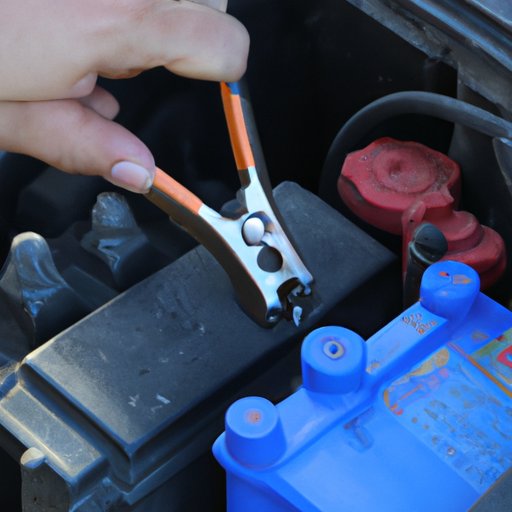Introduction
A car battery is an essential component of any vehicle. Without it, your car won’t start, and you’ll be stranded wherever you are. That’s why it’s crucial to know how to change a car battery, so you can replace it when it’s no longer functioning correctly. In this article, we’ll cover everything you need to know about changing a car battery. From the materials and tools you’ll need to the different types of batteries available, we’ll provide a comprehensive guide so you can complete this task with ease.
Step-by-Step Guide
The first thing you need to do when changing a car battery is to gather the necessary tools and materials. You’ll need a pair of gloves, safety goggles, a wrench, a cleaning brush, and a new battery. Make sure you park your vehicle in a well-lit area with a flat surface. Follow these steps:
Safety precautions and preparation
Start by turning off your car’s engine and removing the keys from the ignition. Then, open the hood and locate the battery. Before continuing, ensure that you’re wearing protective gloves and safety goggles.
Removing the old battery
Using a wrench, loosen the nuts holding the battery cables in place. Start by removing the negative cable first, which is usually black, and place it away from the battery, so it doesn’t touch any metal parts. Then, repeat the process with the positive cable, which is typically red. Once both cables are disconnected, you can remove the battery from its housing.
Cleaning the battery area
Before installing the new battery, clean the battery tray and its surrounding area using a cleaning brush. This step ensures that any corrosion or debris is removed, creating a clean surface for your new battery.
Installing the new battery
Insert the new battery into the tray, carefully aligning the positive and negative terminals. Then, reconnect the battery cables, starting with the positive cable and finishing with the negative cable. Make sure that you tighten the nuts securely, so the cables are firmly attached to the battery.
Testing the new battery
Once the new battery is installed, turn on your car’s engine to ensure it starts correctly. If everything is working correctly, congratulations, you’ve successfully replaced your car battery!
Troubleshooting common problems
If your car won’t start, even after changing the battery, you may have installed it incorrectly. Check your connections, and make sure they are secure. If you’re still having issues, you may need to have a professional inspect your vehicle’s electrical system.
Video Tutorial
Here’s a comprehensive video tutorial that shows you how to change a car battery step-by-step https://www.youtube.com/watch?v=c5E77V4dCJY. The video covers everything in our step-by-step guide with the added benefit of seeing the process in action.
Infographic
Here’s an infographic that depicts the process of changing a car battery using clear visuals. Follow this guide, and you’ll be able to replace your car’s battery in no time.

Common Mistakes
One of the most common mistakes people make when changing their car battery is not wearing protective gloves and safety goggles. The battery contains sulfuric acid, which can cause burns and irritation if it comes in contact with your skin or eyes. Additionally, people often forget to remove the negative cable first, which can cause a short circuit if it touches any metal parts.
Another common mistake is not making sure that the battery is the cause of the vehicle’s starting problem. Conduct a battery check to ensure that the battery is indeed the culprit. You can use a voltmeter to test the battery’s voltage, or take it to a professional mechanic to conduct a thorough battery check.
Different Battery Types
There are two main types of car batteries: lead-acid and absorbed glass mat (AGM). Lead-acid batteries are the most common type and are suitable for most cars. AGM batteries, on the other hand, are more expensive but offer a longer lifespan and work best with high-performance vehicles.
When choosing a battery, consider the size of your car’s engine, the environment you drive in, and your climate. If you’re in a cold climate, a battery with a higher cold cranking amp (CCA) rating is necessary.
Maintenance Tips
To prolong your car battery’s life, it’s essential to keep it well-maintained. Avoid draining your battery fully before recharging it, as this can shorten its lifespan. Additionally, keep the battery and its surrounding area clean and free of debris. Lastly, if your battery is over three years old, consider having it inspected by a professional mechanic to evaluate its functionality.
Conclusion
Changing a car battery may seem intimidating, but with our comprehensive guide, you’ll be able to do it effortlessly. Always prioritize your safety when handling the battery, and remember to choose the right battery that fits your car’s engine and driving environment. By following these steps and learning how to maintain your battery, you’ll ensure that your car starts smoothly every time.
